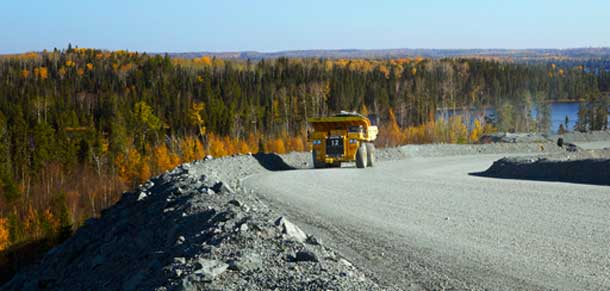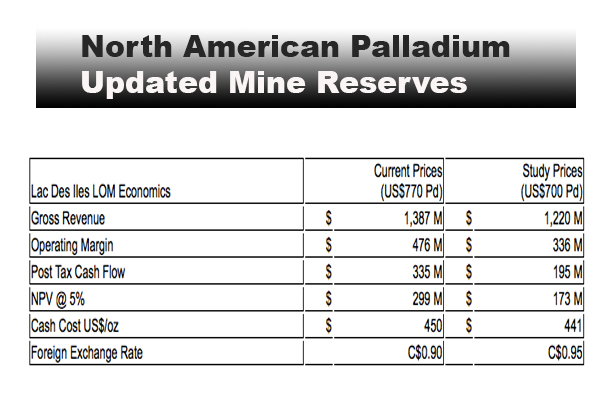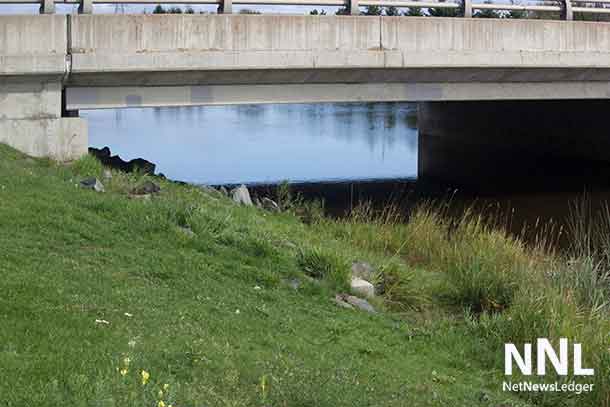
NAP Reports 24% Increase in Palladium Since January
THUNDER BAY – Mining – North American Palladium Ltd. (“NAP” or the “Company”) (TSX:PDL)(NYSE MKT:PAL) is pleased to provide an update on its mineral reserve and resource estimates and life of mine plan for its Lac des Iles mine property in northwestern Ontario. An update of current 2014 operations and production at LDI is also provided.
“We are pleased with the overall increase in contained palladium ounces in our reserves and resources and the improved economics of our updated life of mine plan for LDI,” said Phil du Toit, President and CEO. “Our operations are performing well year to date and the fundamentals for the palladium market remain favorable. As we continue through 2014 we will focus on continued operational improvements, lowering unit costs and further diamond drilling to potentially convert our large mineral resource to reserves.”
Due to the material increase in reserves and resources, the Company is required by regulatory legislation to file a revised NI 43-101 technical report and intends to do so on or before March 31, 2014.
North American Palladium Highlights:
Palladium production and operating costs in January and February were ahead of guidance with positive variances in both months.
Total reserves and resources of 5.2 million ounces of contained Pd is an increase of 24% above the January 2013 technical report.
Of the total reserve, underground reserve accounts for 9.2 million tonnes at a diluted grade of 3.9 g/t Pd. Total reserve is 15.0 million tonnes at a grade of 2.8 grams per tonne (“g/t”) palladium (“Pd”) which now includes salvage mining in the open pit and a portion of the low grade stockpile on surface.
Total reserves increased by 140,000 of contained Pd to 1.3 million ounces. This is an increase of 12% compared to the previous technical report.
Total resources increased by 860,000 ounces of contained Pd to a total of 3.9 million ounces. This is an increase of 28% compared to the previous technical report.
Utilizing only proven and probable reserves, the current Life of Mine (“LOM”) increases by one year to 2019 with annual production peaking over 200,000 payable ounces and a total mined reserve of 1.1 million payable Pd ounces, an increase of approximately 34% from the 2013 technical report. This plan does not include the potential shaft extension to access the lower Offset zone. Management will focus on advancing work to potentially extend the LOM through the future successful conversion of resources into reserves.
A life of mine plan has been completed as part of an updated pre-feasibility study (“PFS”) report that is expected to be filed on SEDAR on or before March 31, 2014.
Addition of large tonnage footwall zone resources in both the Roby and Offset Zone deposits.
The base case net present value (“NPV”) at a 5% discount rate is $173 million (using three year average pricing of US$700 per ounce Pd and a CDN$0.95 foreign exchange rate). Current price scenario using US$770 Pd and CDN$0.90 foreign exchange rate results in an NPV (5%) of $299 million an increase of $161 million from the previous NPV in the January 2013 technical report.
Cash costs of the base case averages US$440 per ounce of payable Pd.
Additional exploration funds are expected to be allocated in 2014 to conduct conversion and extension drilling below the 1000 metre level in the lower part of the Offset Zone in support of a potential shaft expansion and future LOM extension.
“Mine operations continue to perform well with several large stopes in the production cycle and significant broken ore inventory underground. Tonnage mined is as per plan and grade has been above guidance year to date due partly to some strategic stope sequencing decisions made late last year,” said Jim Gallagher, Chief Operating Officer. “Performance at the concentrator has been above guidance with recoveries in the first two months averaging 84.5%, reflecting positive results from the process improvements implemented in December 2013. We have also taken short-term measures to improve throughput of the ore handling system feeding the shaft and are on track to complete permanent solutions in the second half of 2014, which are expected to allow us to achieve higher production rates at lower unit costs.”
Update to Mineral Resources and Mineral Reserves for the Lac des Iles Mine Property
The Company has completed an update to its LDI mineral reserves and resources. The effective date for the new reserve and resource estimates, shown in Table 1, is December 31, 2013. The new estimates exclude material mined up until the effective date. The resource estimates provided in Table 1 were prepared by NAP Qualified Persons in accordance with NI 43-101 guidelines. The reserve estimates provided in Table 1 were prepared by qualified persons from Tetra Tech, also in accordance with NI 43-101 guidelines.
A detailed discussion of the resource and reserve estimates presented in Table 1 will be contained in a NI 43-101 technical report containing an updated pre-feasibility study for the Lac des Iles mine. This report is expected to be filed on SEDAR on or before March 31, 2014. The following discussion provides summary information for the new resource and reserve estimates for LDI with reference to Table 1. Table 2 provides a comparison of tonnage, Pd grade and contained Pd for selected zones and reserve/resource categories between the previous published reserve and resource estimates (see Technical Report entitled “Technical Report Lac des Iles Mine, Ontario, Incorporating Prefeasibility Study Offset Zone Phase I” dated January 31, 2013 and filed on SEDAR February 19, 2013) and the current, updated estimates.
Mineral Resources

The updated mineral resource estimates presented in Table 1 represent a change to the previous, published mineral resources for the LDI mine property (the “Property”). The known mineralized zones on the Property are shown in Figure 1. For the first time the Company is reporting separate hangingwall and footwall zones for the Offset and Roby zone deposits (Figure 2). This change in reporting structure was motivated by the need to better align resource estimates to the geology of these deposits, current and potential, future mining methods and observed Pd grade distribution patterns. The resources reported in Table 1 include the first estimates of footwall zone resources for both the Roby and Offset zone deposits. The former Cowboy and Outlaw zones are now included in the Offset footwall zone. The Offset and Roby hangingwall zones are characterized by higher average grades than their respective, underlying footwall zones. The hangingwall zones are typically hosted by a sheared melanorite unit (also referred to as the ‘pyroxenite unit”). The footwall zones are typically hosted by a more massive varitextured gabbro unit (Figure 2).
In addition to the reporting of separate hangingwall and footwall zones, the LDI resources have been subdivided into three major categories: (i) near surface sources; (ii) underground hangingwall zone resources; and (iii) underground footwall zone resources.
The Company believes that separate listing of these three resource categories is a better representation of the distinctive geology, grade distributions and past, present and future mining methods than the previously published estimates for the Property.
The most significant differences between the currently reported resource estimates (Table 1) and the previously published resource estimates (see January 2013 NI 43-101 Technical Report) are highlighted in Table 2. In summary, the major differences between these two mineral resource estimates include:
- Addition of a large footwall zone resource for both the Roby and Offset zone deposits
- Addition of a pit expansion resource principally located in the southern and western part of the Roby Zone deposit and outside of the limits of the current Roby Zone pit shell
- Conversion of Offset Zone resources between the 990 level and 1065 level to reserves
- Conversion of a portion of the low-grade stockpile to reserves
- Reduction in Offset hangingwall zone resources, largely associated with conversion to reserves and re-assignment of formerly combined Offset Zone higher-grade (>2.5 g/t Pd cut-off grade) resources into separate footwall and hangingwall zones
- Reduction in Offset Zone inferred resources based on negative conversion drilling results in 2012 and 2013 primarily in the area immediately south of the current shaft
- Addition of Offset Zone inferred resources from the newly reported Offset footwall zone resource
The net change to the LDI resource inventory in terms of contained Pd is an increase of 858,000 ounces, bringing the total measured and indicated resource to 3.86 million ounces of contained Pd, comprising:
- Near-surface measured and indicated resources of 25.8 million tonnes having a Pd grade of 1.44 g/t (1.2 million ounces of contained Pd)
- Underground hangingwall zone measured and indicated resources of 5.7 million tonnes having a Pd grade of 4.25 g/t (0.8 million ounces of contained Pd)
- Underground footwall zone measured and indicated resources of 26.3 million tonnes having a Pd grade of 2.24 g/t (1.9 million ounces of contained Pd)
Although the overall mineral resource on the Property has increased, internal technical studies will be required to assess the potential for profitable mining of the large footwall zone resources shown in Table 1 by considering a range of bulk underground mining methods. Similarly, the Company intends to investigate incentive prices for the recently added near-surface mineral resources (Table 1) through future pit optimization studies and associated financial modeling.
Mineral Reserves
The updated mineral reserve estimates presented in Table 1 are also divided into the three main categories cited above for the LDI resources. Major changes in the Property reserves compared to the most recent, prior estimate (see NI 43-101 Technical report dated January 31, 2013) include:
- Depletion from mining activities in 2012 and 2013 to previously reported Roby pit and Roby underground reserves (largely mined out)
Net gain in total proven and probable reserves of 141,000 ounces of contained Pd, largely reflecting the conversion of low-grade surface stockpile resources and despite significant depletion from mining activities in 2013, which resulted in the extraction of 817,000 tonnes of higher-grade underground ore (116,000 ounces of contained Pd) from both the Offset and Roby hangingwall zones
Addition of a small reserve (pit salvage reserve) from the bottom-west portion of the current Roby pit and containing 1.01 million tonnes having an average grade of 1.33 g/t Pd
Slight reduction in the average Pd grade for the Offset Zone reserves (hangingwall zone) based on refinements to the life of mine plan (see below) and the addition of new reserves at deeper levels (1065 level)
Underground proven and probable reserves are currently restricted to the Roby and Offset hangingwall zones and total 9.16 million tonnes having an average diluted Pd grade of 3.89 g/t (1.15 million ounces of contained Pd). New reserves for the Roby hangingwall zone incorporate sill pillars and remnant mineralization located at both the northern end of the Roby underground mining developments (Roby 6 Block reserves) and beneath the lowermost development level.
Near surface proven and probable reserves total 5.89 million tonnes with an average grade of 1.03 g/t Pd (0.195 million ounces of contained Pd).
2014 Exploration and Conversion Drilling Plans
The Company plans to continue investing in surface and underground exploration and conversion drilling with the 2014 campaign scheduled to begin at the end of this month. Drilling will initially focus on converting inferred resources to indicated resources in the lower part of the Offset Zone and adding inferred resources in both the upper and lower parts of the Offset Zone to aid in defining the along strike and down dip extent of the deposit to depths ranging from within surface to approximately 1500 m below surface. The scope of the 2014 exploration and conversion drilling program will be determined pursuant to the results of ongoing financing activities.
Update to Life of Mine Plan
An updated Life of Mine Plan has been completed by Tetra Tech with significant contributions from NAP qualified persons. The updated Life of Mine Plan will be included in a technical report that the Company plans to file on SEDAR on or before March 31, 2014. Whereas the 43-101 report issued in January 2013 looked at the lower Offset zone project only, the updated plan looks at all mineable reserves from all sources to form a complete Life of Mine plan. It also includes an updated accounting of all resources at the Lac Des Iles site.
Changes to the Life of Mine Plan include:
Mining of the Offset zone down to the 1065 level (previously to 990 level only).
Inclusion of sill pillar recovery and remnant stopes in the upper Roby zone.
Inclusion of part of the low grade surface stockpile into reserves as a blended feed with the underground ore.
A final open pit salvage operation at the end of mine life.
This plan does not require significant capital expenditures other than ongoing capital development of the lower Offset zone and ongoing expansion of the tailings management facility.
The underground mine plan continues with large sublevel blast hole open stopes with waste fill as has been the practice to date at LDI. Ore is hauled to the 645 metre level ore handling system and is hoisted via the shaft. Some of the remnant ore from the upper Roby zone will continue to be trucked to surface due to the relatively short haulage distance. The average production rate from underground from all sources is expected to be 5000 tonnes per day. The underground ore will be blended on surface with the low grade stockpile with an expected rate of approximately 12,000 tonnes per day for the two week mill run each month. For this reason the portion of the low grade stockpile that will be mined has now been moved into the reserve category.
A final, low cost salvage of remaining open pit reserves will be taken at the end of mine life to avoid impacting active underground infrastructure.
Opportunities
During the course of the study several high potential opportunities were identified that require either higher metal prices than the base case (US$700/oz Pd), additional resource definition drilling or detailed engineering studies before they could be included in the LOM. These include:
The extension of the mine to the known depth with a deepened mine shaft. A significant inferred resource has already been identified in the lower Offset zone. Additional diamond drilling is required to expand the total resource and upgrade portions to measured and indicated resources so that PFS level engineering studies can be completed and potentially prove the economic viability of the shaft deepening project. This opportunity has the potential to increase total shaft throughput and extend the life of mine plan (“LOM”) by several years. The Company intends to commence definition and conversion drilling in the lower Offset zone later this month.
Open pit mine life. The currently planned salvage operation in the pit has a life of approximately one year. The new reserve and resource estimate include a pit expansion resource that could potentially be developed near the end of the current mine plan, depending on metals prices and economic factors at that time.
Mining of the Roby and Offset footwall zones. A measured and indicated resource of 26.3 million tonnes at 2.2 g/t Pd (undiluted) exists as the contiguous footwall of the existing Roby and Offset zone deposits. As part of the current mine plan, the necessary mine infrastructure will already be in place to extract this resource. The potential to mine this exists as a relatively low cost operation at end of mine life and with better than base case metal prices. Further evaluation is required.
Several near surface exploration targets will be assessed as part of the Company’s future surface exploration programs.
Economic Analysis
As per 43-101 guidelines the LOM economics were based on the lesser of the three year average pricing or the current spot price. Standard sensitivities were run and will be contained in the report. Current pricing as of March 17, 2014 was also run and is reflected in the table below. Pd price and the exchange rate of the Canadian dollar relative to the US dollar both have a significant impact of the mines cash flow.










